Diocese of Honolulu Diœcesis Honoluluensis | |
|---|---|
 Cathedral Basilica of Our Lady of Peace | |
 Coat of arms | |
| Location | |
| Country | |
| Territory | State of Hawaiʻi, Unincorporated Hawaiian Islands |
| Ecclesiastical province | San Francisco |
| Statistics | |
| Area | 6,435 sq mi (16,670 km2) |
| Population - Total - Catholics | (as of 2013) 1,325,000 263,000 (19.8%) |
| Information | |
| Denomination | Catholic |
| Sui iuris church | Latin Church |
| Rite | Roman Rite |
| Established | January 25, 1941 |
| Cathedral | Cathedral Basilica of Our Lady of Peace |
| Co-cathedral | Co-Cathedral of Saint Theresa of the Child Jesus |
| Patron saint | Our Lady of Peace[1] |
| Current leadership | |
| Pope | Francis |
| Bishop | Clarence Richard Silva |
| Metropolitan Archbishop | Salvatore J. Cordileone Archbishop of San Francisco |
| Map | |
 | |
| Website | |
| catholichawaii.org | |
The Diocese of Honolulu (Latin: Diœcesis Honoluluensis) is a Latin Church ecclesiastical territory or diocese of the Catholic Church for the state of Hawaii in the United States.[2] It is a suffragan diocese in the ecclesiastical province of the metropolitan Archdiocese of San Francisco.[3]
The mother church of the Diocese of Honolulu is the Cathedral Basilica of Our Lady of Peace in Honolulu. As of 2023, the bishop of Honolulu is Clarence Silva.
Description
The patron saint of the Diocese of Honolulu is the Blessed Virgin Mary, under the title of Malia O Ka Malu or Our Lady Queen of Peace. Other saints associated with the diocese include Damien De Veuster and Marianne Cope.
The diocese ministers to Hawaiian, English, Ilokano, Tagalog, Samoan, Tongan, Japanese, Korean, Spanish, and Vietnamese congregants.
History
1825 to 1831
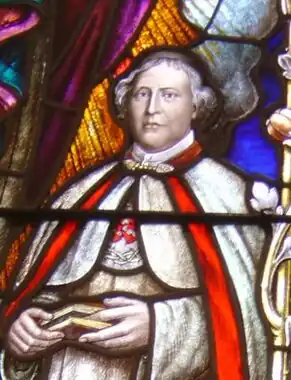
In 1825, Pope Leo XII established the Prefecture Apostolic of the Sandwich Islands, a part of the Vicariate Apostolic of Oriental Oceania. He tasked the Picpus Order with evangelizing the Kingdom of Hawaii (then known as the Sandwich Islands). Leo XII appointed the missionary Reverend Alexis Bachelot as its prefect.[4][5]
Bachelot and two other Picpus priests, Reverend Abraham Armand and Reverend Patrick Short, arrived in Honolulu in the summer of 1825. However, the Hawaiian royalty had converted to Protestantism four years earlier. Queen Kaʻahumanu ordered the priests deported, but the ship captain refused to take them because he had received no payment for their passage. After a two-day standoff, Kaʻahumanu allowed the three priests to remain in Hawaii.
When the three priests finally disembarked, they were joined by six lay brothers. They performed the first baptism in November 1825. The priests began their missionary work, but encountered suspicion from most chiefs. The priests had problems communicating their intentions as none of them was fluent in English or Hawaiian.[6] However, the priests received support from the high chief Boki, the royal governor of Oahu, and his wife Kuini Liliha.
The Picpus priests learned the local language, went into the Native Hawaiian community and began preaching to them. They distributed Hawaiian language Bibles. Hundreds of Native Hawaiians were baptised. The first converts included Kalanimoku, chief minister of the kingdom, Boki and Liliha.[7]
1831 to 1840

The American Congregationalist missionaries in Hawaii were alarmed at the growth of Catholicism in the islands. They influenced Kaʻahumanu to persuade King Kamehameha III to enact repressive policies against Catholics. The king expelled Bachelot and Short in 1831 and banned other priests from entering the Kingdom. After the priests' departure, many Native Hawaiian converts complained of being imprisoned, beaten and tortured. Commodore John Downes of the United States Navy USS Potomac intervened on the converts' behalf with Kamehameha III, stopping the mistreatment.[8][7]
In 1835, Vicar Apostolic Étienne Rouchouze and Bachelot dispatched Columba Murphy, a Picpus religious brother, to Hawaii to evaluate the situation. Kamehameha II allowed Murphy to enter the kingdom since he was not a priest. After several months, Murphy left to report to his superiors.
In 1836, Bachelot sent Arsenius Walsh to Honolulu to continue Murphy's work. Kamehameha III initially refused Walsh's entry, but a French naval officer persuaded the king to let him stay. Kamehameha III also agreed to permit the Picpus Fathers to work freely in Hawaii so long as they only ministered to foreigners.[7]
In April 1837, Bachelot and Short sailed into Honolulu, thinking that they were now allowed back. However, two weeks later, the Hawaiian government forced them back on their ship. The American and British consuls, with the assistance of the Royal Navy and the French Navy, forced Kamehameha III to allow Bachelot and Short to disembark. In July 1839, the French Navy frigate Artemise sailed into Honolulu Harbor.[8][7] Captain Cyrille Laplace had been ordered by his government to:
''...to make it well understood that it would be to the advantage of the chiefs of those islands of the Ocean to conduct themselves in such a manner as not to incur the wrath of France.''
Fearing a French assault, Kamehameha III issued the Edict of Toleration in July 1839, granting religious freedom to all Catholics in Hawaii.[9]
1840 to 1847
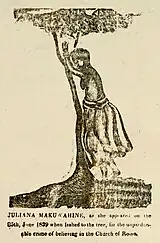
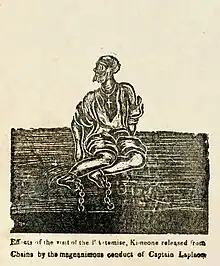
Shortly after the Edict of Toleration was issued, Rouchouze arrived in Honolulu with three Picpus priests, including the previously exiled Louis Maigret. The priests broke ground on Our Lady of Peace in Honolulu, the first permanent church in Hawaii, in 1840. As an act of reconciliation, Kamehameha III had donated land for the church.[8][10]
During the groundbreaking mass, 280 Native Hawaiian catechumens received the sacraments of baptism and confirmation. For the rest of 1840, devotees harvested large blocks of coral off the Oahu coastline to build the future Cathedral Basilica of Our Lady of Peace.[10]
Rouchouze commissioned the construction of mission churches and schools. He imported a printing press to Honolulu to produce missals and hymnals in the Hawaiian language. St. Raphael's Parish was established on the Island of Kauai in 1841, the first Catholic church there[11]
In January 1842, Rouchouze set sail to France to recruit more Picpus priests and brothers to serve in Hawaii. However, his ship was lost at sea. In 1846, the first Catholic priest arrived on the island of Maui.[8]
1847 to 1892
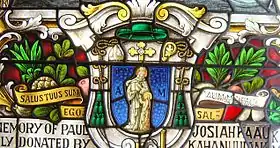
Five years after Rouchouze's disappearance, the Vatican decided in 1847 to elevate the prefecture of the Sandwich Islands to the Vicariate Apostolic of the Sandwich Islands.[12]
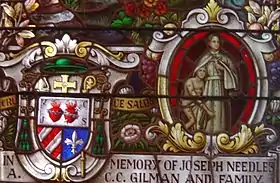
Pope Pius IX appointed Maigret in 1847 as the first vicar apostolic of the Sandwich Islands.[13] The next year, the vicariate was renamed the Vicariate Apostolic of the Hawaiian Islands.[14]
The first Catholic church in Hilo on the Island of Hawaii, Saint Martin of Tours, was completed in 1848.[15] Maigret completed the construction of the Cathedral Basilica of Our Lady of Peace. He also invited the Sisters of the Sacred Hearts of Jesus and Mary and priests and religious brothers of the Society of Mary (Marianists) to open schools in the kingdom. The first permanent church on Maui, Maria Lanakila, was dedicated in 1858. Maigret died in 1882.
Pope Leo XIII named Bernard Koeckemann as the second vicar apostolic of the Hawaiian Islands.[16] During his episcopate, over 16,000 Catholic Portuguese workers arrived in Hawaii to work on the sugarcane plantations. Given the simultaneous decline in the Native Hawaiian population, Koeckemann focused his evangelism efforts on the new immigrants. He made Catholic education a priority and built many schools.[8]
Koeckemann also saw the rise of leprosy cases throughout the kingdom. Kamehameha III ordered all leprosy patients to confine themselves to the Kalaupapa Leper Colony on the island of Molokai. In 1873, Reverend Damien De Veuster went to Kalaupapa to minister to these people.[17] Sister Marianne Cope and six sisters of St Francis arrived in Hawaii in 1883 from Syracuse, New York, to operated the leper colony.[10] Koeckemann died in 1892.[8]
1892 to 1961
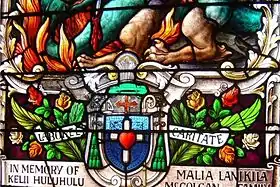
In 1892, Leo XIII named Gulstan Ropert as third vicar apostolic of the Hawaiian Islands.[18] One year later, a group of American businessmen, aided by a contingent of United States Marines, overthrew Queen Liliʻuokalani and established a Republic of Hawaii.[19] Many Native Hawaiian Catholics urged Ropert to speak out against Liliʻuokalani being tried for treason, but he remained silent.
Ropert provided support to the Hawaiian families of men who fought in the Spanish–American War of 1898 and the Philippine–American War of 1899 to 1902. In 1900, the Republic of Hawaii was admitted to the United States as the Territory of Hawaiʻi. Ropert died in 1903.

The next vicar apostolic of the Hawaiian Islands was Monsignor Libert Boeynaems, appointed by Leo XIII in 1903.[20] With the establishment of Naval Station Pearl Harbor in 1900, Fort Shafter in 1907, and Schofield Barracks in 1908 Boeynaems started ministering to many Catholics in the US Armed Forces. To assist Boeynaems, Pope Pius XI appointed Stephen Alencastre in 1924 as coadjutor vicar apostolic.[21]
After Boeynaems died in 1926, Alencastre automatically became the next vicar apostolic. He also oversaw the renovation of the Cathedral Basilica of Our Lady of Peace, modernizing it in time for the centennial celebration of the Catholic Church in Hawaii in 1927.[10] Alencastre died in 1940.
1961 to 1982
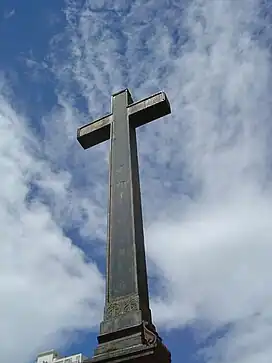
Pope Pius XII in 1941 suppressed the Vicariate Apostolic of the Hawaiian Islands, replacing it with the Diocese of Honolulu. He appointed Monsignor James Joseph Sweeney of San Francisco as the first bishop of Honolulu.[2] The diocese established the Saint Stephen Diocesan Seminary in Kalihi Valley in 1946.[22]
Motivated by the reforms of the Second Vatican Council in the early 1960s, Sweeney renovated the Cathedral Basilica of Our Lady of Peace in keeping with the newly promulgated Constitution on the Sacred Liturgy. Soon all the parishes offered Mass primarily in the vernacular in place of Latin and altars were built facing the congregation instead of the sanctuary wall.[10] Other languages were incorporated into the mass including the Hawaiian language. Sweeney also invited the Marist Fathers and Brothers to staff several parishes on Oahu and Kauai. In 1959, Hawaii was admitted as a state. Sweeney died in 1968.
Pope Paul VI in 1954 appointed Auxiliary Bishop John Scanlan of Honolulu as the second bishop of Honolulu.[23] Scanlan invited the Society of Jesus, the Christian Brothers of Ireland, the Religious of the Virgin Mary, and the Dominican Sisters of Iloilo to enter the diocese. The Jesuits primarily ministered to the students of the University of Hawaii at Mānoa. Five Marianist priests established St. Louis Junior College in Honolulu in 1955. It would later become Chaminade University of Honolulu.[24] Scanlan retired in 1981.
1982 to 2005

The next bishop of Honolulu was Auxiliary Bishop Joseph Ferrario of Honolulu, selected by Pope John Paul II in 1982.[25] Ferrario revamped major diocesan offices and appointed pastors to parishes that were supportive of his vision of implementing the Second Vatican Council. Ferrario's harshest critics were the conservative followers of the Archbishop Marcel Lefebvre's Society of Saint Pius X. Ferrario, through his judicial vicar, Joseph Bukoski, issued a canonical decree of excommunication to six individuals in that group in 1991. Cardinal Joseph Ratzinger, prefect of the Congregation for the Doctrine of the Faith, reversed the excommunications.[26] Ferrario retired in 1993.
In 1994, John Paul II, appointed Auxiliary Bishop Francis DiLorenzo from the Diocese of Scranton as the fourth Bishop of Honolulu. He served in Honolulu until his appointed as bishop of the Diocese of Richmond in 2004.[27]
2005 to present

Monsignor Clarence Silva of San Francisco became the first native-born bishop of Honolulu, named by Pope Benedict XVI in 2005.[28] Over 3,500 attended his consecration, making it one of the largest events ever held by the diocese.
Silva was a principal promoter for the causes of sainthood for Damien De Veuster and Marianne Cope. Silva travelled to Kalaupapa in 2005 to pay homage to them.[29]Damien was canonized in 2009 and Cope in 2012. [30][31]
As of 2023, Silva is the bishop of Honolulu.
Sex abuse
In 1989, David Figueroa anonymously accused Bishop Ferrario of sexually abusing him when he was a young child in Kailua. Figueroa said that the abuse continued after Ferrario became bishop. Ferrario denied the accusations and noted that the Vatican had previously investigated them, deciding that they were not valid.[32] Figueroa revealed himself as the accuser in an appearance in 1990 on the Geraldo TV show. He sued the diocese in 1991.[33] By 2013, two more men had filed lawsuits, accusing Ferrario of sexual abuse when they were children.[34]
In 2003, Bishop DiLorenzo removed Reverend Roberto Batoon as pastoral administrator of Molokai Catholic Community, a cluster of parishes on the Island of Molokai. Batoon had been accused of sexual abuse by several individuals when he was a priest in the Philippines.[35]
In April 2020, Bishop Silva announced during a Sunday mass that the diocese was paying millions to settle prior sex abuse cases.[36] Silva also acknowledged that the diocese was still facing a large of number of sex abuse lawsuits as well.[36]
Bishops
Vicar Apostolic of the Sandwich Islands
Louis Desire Maigret, SS.CC. (1847–1848)
Vicars Apostolic of the Hawaiian Islands
- Louis Desire Maigret, SS.CC. (1848–1882)
- Herman Koeckemann, SS.CC. (1882–1892)
- Gulstan Ropert, SS.CC. (1892–1903)
- Libert H. Boeynaems, SS.CC. (1903–1926)
- Stephen Alencastre, SS.CC. (1926–1940)
Bishops of Honolulu
- James Joseph Sweeney (1941–1968)
- John Joseph Scanlan (1968–1981)
- Joseph Anthony Ferrario (1982–1993)
- Francis X. DiLorenzo (1994–2004), appointed Bishop of Richmond
- Clarence Richard Silva (2005–present)
Auxiliary bishops
- John Joseph Scanlan (1954-1968), appointed Bishop here
- Joseph Anthony Ferrario (1978-1982), appointed Bishop here
Special anniversaries

- January 23 – Memorial to Marianne Cope (2005)
- January 25 – Anniversary of the erection of the diocese (1941)
- May 10 – Memorial to Saint Damien of Molokai, religious (1995)
- May 17 – Anniversary of the appointment of Clarence Silva as bishop of Honolulu (2005)
- July 9 – Memorial to the Blessed Virgin Mary under the title Queen of Peace
- July 28 – Anniversary of the dedication of the Co-Cathedral of Saint Theresa of the Child Jesus (1985)
- August 15 – Anniversary of the dedication of the Cathedral Basilica of Our Lady, Queen of Peace (1843)
Parishes
Notable people
Saints, Blesseds, and Servants of God
- Damian de Veuster (1840–1889), priest of the Picpus Order who established the leper colony on Molokai
- Marianne Cope (1838–1918), member of the Franciscan Sisters of Syracuse who worked with the lepers in Hawaii
- Joseph Dutton (1843–1931), lay missionary in Hawaii
Other notable parishioners
- Helio Koa'eloa (c. 1815 – 1846), lay missionary
- Gulstan-Francois Ropert (1839–1903), priest of the Picpus Order who was Apostolic Vicar of the Hawaiian Islands
- Ambrose Kanoealu'i Hutchison (c. 1856 – 1932), lay superintendent of the leper colony of Molokai
- Leopoldina Burns (Maria Leopoldina) (1855–1942), member of the Franciscan Sisters of Syracuse who served at the leper colony
- Aloysius Schmitt (1909–1944), priest and chaplain who displayed heroism during the 1941 Japanese attack on Pearl Harbor.
High schools
- Damien Memorial School – Honolulu
- Maryknoll School – Honolulu
- Sacred Hearts Academy – Honolulu
- Saint Louis School – Honolulu
- St. Anthony High School – Wailuku
- St. Joseph High School – Hilo
- St. Michael High School – Waialua
Closed schools
- Saint Francis School – Honolulu
Arms
 |
|
See also
References
- ↑ "2021 Liturgical Notes for the Diocese of Honolulu" (PDF). Retrieved September 11, 2022.
- 1 2 "Catholic Hierarchy Profile of the Diocese of Honolulu". Retrieved 2007-04-03.
- ↑ "Archdiocese of San Francisco Description". Archived from the original on 2006-12-29. Retrieved 2007-04-03.
- ↑ "Congregation of the Sacred Hearts of Jesus and Mary and of the Perpetual Adoration of the Blessed Sacrament of the Altar". New Advent. Retrieved 2007-04-03.
- ↑ Wiltgen, Ralph M (2010). "Chapter 1". The Founding of the Roman Catholic Church in Oceania, 1825 to 1850. Eugene, Oregon: Pickwick. ISBN 9781608995363.
- ↑ Garrett, John (1982). To live among the stars: Christian origins in Oceania. Institute of Pacific Studies. p. 50. ISBN 978-2-8254-0692-2.
- 1 2 3 4 "This is a story with more than one beginning". Saint Joseph Catholic Church. Retrieved 2023-10-16.
- 1 2 3 4 5 6 "Hawaii, The Catholic Church". Encyclopedia.com. Retrieved 2023-05-12.
- ↑ "Iulai 12-17: Kuʻikahi me Farani ("Kuikahi e Hooki i ke Kaua") | Punawaiola". University of Hawaii Manoa. Retrieved 2023-10-16.
- 1 2 3 4 5 "The history of Catholicism's mother church in Hawaii". Hawaii Catholic Herald. 2018-08-08. Retrieved 2023-10-16.
- ↑ Moffat, Riley M.; Fitzpatrick, Gary L. (2004). "Mapping the lands and waters of Hawaiʻi". www.ulukau.org. Retrieved 2019-05-29.
- ↑ "New Advent article on the Vicariate Apostolic of the Sandwich Islands". Retrieved 2007-04-03.
- ↑ "Bishop Louis-Désiré Maigret [Catholic-Hierarchy]". www.catholic-hierarchy.org. Retrieved 2023-10-16.
- ↑ "Honolulu (Diocese) [Catholic-Hierarchy]". www.catholic-hierarchy.org. Retrieved 2023-10-16.
- ↑ "Two Hilo-side Big Island churches hit the century mark". Hawaii Catholic Herald. 2019-03-20. Retrieved 2023-10-16.
- ↑ "Bishop Bernard Hermann Koeckemann [Catholic-Hierarchy]". www.catholic-hierarchy.org. Retrieved 2023-10-16.
- ↑ Boeynaems, Libert. "Father Damien (Joseph de Veuster)." The Catholic Encyclopedia Vol. 4. New York: Robert Appleton Company, 1908. 20 April 2020
 This article incorporates text from this source, which is in the public domain.
This article incorporates text from this source, which is in the public domain. - ↑ "Bishop Gulstan Francis Ropert [Catholic-Hierarchy]". www.catholic-hierarchy.org. Retrieved 2023-10-16.
- ↑ Network, The Learning (17 January 2012). "Jan. 17, 1893 | Hawaiian Monarchy Overthrown by America-Backed Businessmen". The Learning Network. Retrieved 2017-03-27.
- ↑ "Bishop Libert Hubert Jean Louis Boeynaems [Catholic-Hierarchy]". www.catholic-hierarchy.org. Retrieved 2023-10-16.
- ↑ "Bishop Stephen Peter Alencastre [Catholic-Hierarchy]". www.catholic-hierarchy.org. Retrieved 2023-10-16.
- ↑ "Diocese of Honolulu". Diocese of Honolulu. Retrieved 2023-10-16.
- ↑ "Bishop John Joseph Scanlan [Catholic-Hierarchy]". www.catholic-hierarchy.org. Retrieved 2023-10-16.
- ↑ "Our History". Chaminade University of Honolulu. 2018-08-22. Retrieved 2023-10-16.
- ↑ "Bishop Joseph Anthony Ferrario [Catholic-Hierarchy]". www.catholic-hierarchy.org. Retrieved 2023-10-16.
- ↑ Honolulu Diocese & "The Hawaii Six" Archived 2004-05-02 at the Wayback Machine
- ↑ "Bishop Francis Xavier DiLorenzo [Catholic-Hierarchy]". www.catholic-hierarchy.org. Retrieved 2023-10-16.
- ↑ "Bishop Clarence Richard Silva [Catholic-Hierarchy]". www.catholic-hierarchy.org. Retrieved 2023-10-16.
- ↑ "In the Footsteps of Father Damien". Honolulu Star Bulletin. July 24, 2005. Retrieved 2023-10-16.
- ↑ "Saint Damien of Molokai". Diocese of Honolulu. Retrieved 2023-10-16.
- ↑ "Saint Marianne". Diocese of Honolulu. Retrieved 2023-10-16.
- ↑ Ostling, Richard N.; Dolan, Barbara (August 19, 1991). "Sins of the Fathers: A Honolulu bishop is accused of sex abuse in a federal lawsuit". Time Magazine. Retrieved 2023-10-17.
- ↑ Witham, Larry (August 14, 1991). "Hawaii Bishop Denies Sexual Abuse Charges". Washington Times. Retrieved 2023-10-17.
- ↑ Sakahara, Tim (December 11, 2013). "More Than 30 People in Hawaii Suing Catholic Church for Abuse". The Hawaii News Now. Retrieved 2023-10-17.
- ↑ "Molokai Priest Removed for Alleged Abuse in Philippines, by Adamski, Mary, Honolulu Star - Bulletin (Hawaii), January 28, 2003". www.bishop-accountability.org. Retrieved 2022-04-16.
- 1 2 Daysog, Rick. "About 100 victims come forward with new claims of sex abuse". Hawaii News Now. Retrieved Apr 5, 2021.
External links
- Roman Catholic Diocese of Honolulu Official Site
- Roman Catholic Archdiocese of San Francisco
- Cathedral Basilica of Our Lady of Peace Archived 2005-03-11 at the Wayback Machine
- French in Hawaiʻi by Hawaiʻi History
- Life in Hawaiʻi by Titus Coan
- Catholic Missions in the 19th and 20th Century (in French)